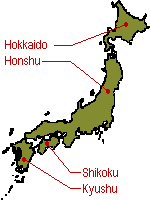 |
The UN Seahorse in Japan! Commemorating the Year of the Ocean |
 |
The UN Seahorse in Japan! Commemorating the Year of the Ocean |
 Japan is in East Asia, comprising four large islands, as well as the Ryukyu Islands farther south and more than 1,000 lesser adjacent islands. Japan proper consists of the large islands of Hokkaido, the northernmost; Honshu, the largest, called the mainland; Shikoku; and Kyushu, the southernmost. The total area of Japan is 377,800 sq.km. (145,869 square miles), about the area of Germany. Due to mountainous regions, only 125,500 sq.km. is habitable. Japan is in East Asia, comprising four large islands, as well as the Ryukyu Islands farther south and more than 1,000 lesser adjacent islands. Japan proper consists of the large islands of Hokkaido, the northernmost; Honshu, the largest, called the mainland; Shikoku; and Kyushu, the southernmost. The total area of Japan is 377,800 sq.km. (145,869 square miles), about the area of Germany. Due to mountainous regions, only 125,500 sq.km. is habitable. The Sea of Okhotsk is to the north of the four main islands of Japan, the Pacific Ocean is to the east and south, the East China Sea is to the southwest, and the Korea Strait and the Sea of Japan are on the west. On the Asian continent, Russia is to the north and northwest of Japan, and North Korea, South Korea, and China are to the west. Taiwan lies to the west of Japan's Ryukyu Islands (See the Maps section for detailed maps of Japan and the surrounding areas.
Due to the mountainous nature of the terrain, most rivers are short, fast flowing and shallow. So most rivers are not navigable - and a network of ports and harbours, and key highways, serve the purpose of transportation of goods. Japan has few, if any, natural resources. It depends on much of its raw material needs on imports from other countries. Please send them to the email listed below. |
| Return to the UN Seahorse Page Contact: Hari Srinivas - oceans@gdrc.org |